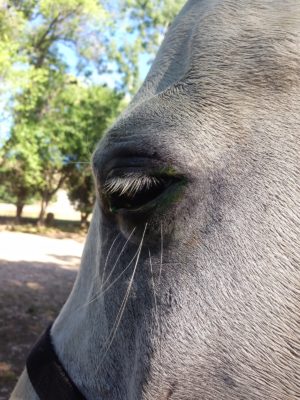Recurrent Uveitis, Anterior Uveitis, Periodic Ophthalmia, and Moonblindness in Horses
by Robert N. Oglesby DVM
Introduction
Introduction
»
What is Uveitis?
»
Clinical Signs and Symptoms
»
Causes
»
Diagnosis
»
Treatment
»
Prevention of Recurrent Episodes
»
Prognosis
»
More Info & Discussions
|
Recurrent uveitis (RU)is a common eye disease affecting middle age and older horses. It has been estimated that as many as 12% of the horse population contracts this disease and it is the most common reason that horses develop blindness. Recurrent uveitis has a number of names but they all represent the same disease process, a recurring noninfectious painful inflammation of the eye. Recent advances include a better understanding of the role of Leptospirosis as an underlying cause and surgical treatments like cyclosporin implants and vitrectomy. Besides these advances, this article discusses symptoms, diagnosis, treatment, and prognosis. Recent research summaries are included.
|

A common appearance to early Recurrent Uveitis: squinting, mildly swollen lens, and usually tearing would be present,
|
What is Uveitis?
Introduction
»
What is Uveitis?
»
Clinical Signs and Symptoms
»
Causes
»
Diagnosis
»
Treatment
»
Prevention of Recurrent Episodes
»
Prognosis
»
More Info & Discussions
Uveitis means inflammation of the uveal tract of the eye. The uveal tract is the vascular (where the blood vessels are) coat of the eye and includes: the iris, the ciliary body, and the choroid. For help with the anatomy see:
Illustration of the Interior Structures of the Eye.
(Note, by right clicking the link and selecting open in a new window you can keep the illustration in front of you as you read.)
The ciliary body lies just behind the iris. This structure controls the iris opening and closing in response to changing light and is responsible for secreting the fluids that fill the eye. The choroid is a thin vascular layer that lies just under the sclera which is the white outer portion of the eye, and covers the whole globe.
Equine Recurrent Uveitis (RU) is recognized by repeated episodes of eye inflammation that develop weeks to months after an initial uveitis episode subsides. In active RU a breakdown of the blood-ocular barrier occurs, with infiltration of cloudiness of the cornea from edema and the anterior chamber from inflammatory cells and protein occurs. The pupil contracts, the iris is hyperemic and the horse squints the painful eye. Tearing is common.
Clinical Signs and Symptoms
Introduction
»
What is Uveitis?
»
Clinical Signs and Symptoms
»
Causes
»
Diagnosis
»
Treatment
»
Prevention of Recurrent Episodes
»
Prognosis
»
More Info & Discussions
You have just read the beginning of this article. To access the unabridged article
become a Member of Horseadvice.com! Your membership gets you instant access to this and over 600 articles on our site. Other benefits of your membership include participation in our discussion boards and access to our one button PubMed search tool for each topic.
Horseadvice can teach you to be a more knowledgeable horse owner which leads to a healthier horse and save you money. Really, we guarantee it.
Come Join Us!
